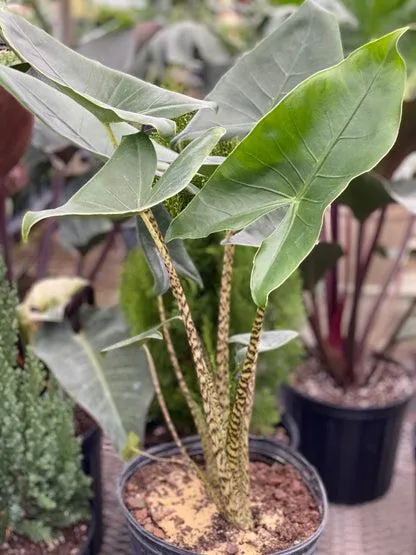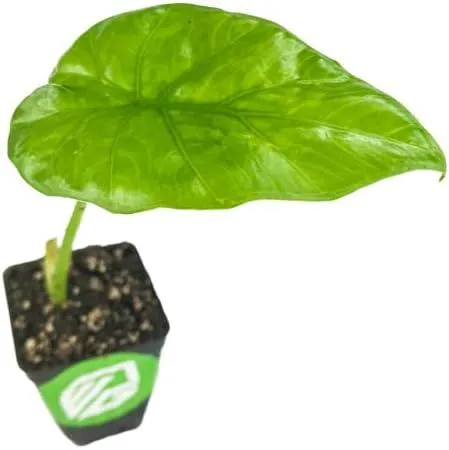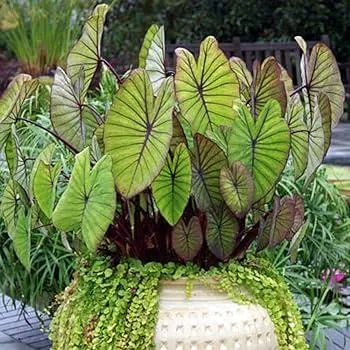Everything You Need to Know About Alocasia Gloriosum, the Exotic Beauty From Southeast Asia
The alocasia gloriosum, commonly known as elephant’s ear, is a striking tropical plant species native to Southeast Asia. As an exotic houseplant lover, part of your quest is likely to learn all about new and interesting plants from around the world. In this in-depth guide, I’ll cover everything you need to know about growing and caring for the gorgeous alocasia gloriosum.
Overview
Let’s start with the basics. Alocasia gloriosum is a member of the Alocasia genus in the arum family. It’s a rhizomatous perennial herbaceous plant that produces large, arrow-shaped leaves on thick, pliant stems. The leaves can reach up to 3 feet long and 2 feet wide, giving the plant its signature “elephant ear” name. From my experience caring for alocasias, what stands out most is their uniquely textured, glossy leaves that come in various shades of green.
Native to tropical rainforests in Southern India and Southeast Asia, alocasia gloriosum thrives in humid environments with rich, organic soil. In habitats like abandoned rubber plantations, it uses its large leaves to trap water and nutrients. Some key attributes that make this species so distinctive and desirable as an indoor plant include its brightly patterned leaves, tolerance of low light, and ability to produce striking red stems when stressed.
Care Requirements
Now that you know the basics, let’s dive into exactly what it takes to keep an alocasia gloriosum happy and healthy indoors. Here are some essential care tips:

- Water – Keep the soil consistently moist but not soggy. Allow the top inch to dry out between waterings. Mist leaves often to boost humidity.
- Light – Provide bright, indirect light. They tolerate low light but may grow leggy without enough sun. Avoid direct rays which can burn leaves.
- Soil – Use a well-draining, organic potting mix. I find adding perlite or orchid bark promotes drainage to prevent root rot.
- Fertilizer – Feed monthly in spring and summer with a balanced houseplant formula. Dilute to 1/2 strength and water through.
- Temperature – Keep above 60°F for active growth. Temps between 70-80°F are ideal. Watch for leaf drop below 60°F.
- Humidity – Maintain above 50%. Mist leaves regularly and use a pebble tray or humidifier. Reduced humidity leads to brown leaf tips and edges.
With some trial and error to dial in the right conditions for your space, you’ll be rewarded with these stunning plants for years to come. Like many tropicals, alocasias are finicky but the effort pays off in beautiful foliage.
Pruning and Propagation
An exciting perk of alocasia gloriosum ownership is their ease of propagation. Every time the plant puts out a new “pup”, you gain the opportunity to expand your collection! Here are the basics:
- Pruning – Cut off pups with a couple inches of stem when they emerge from the mother plant. Allow cuts to callus over before potting.
- Potting – Plant pups in a well-draining soil mix. Water sparingly until roots develop to prevent rot. Place in bright, indirect light.
- Growth – Maintain warm temperatures and high humidity. Supplement with a liquid fertilizer monthly. Pups will soon develop their unique leaf patterns.
You can also divide the rhizome in spring if your plant’s growth becomes cramped. Each section with a node has the potential to sprout a new plant. In my experience, alocasias are fun and rewarding plants to propagate.
Problems and Solutions
While generally low-maintenance, alocasias may occasionally face a few issues that all plant parents must combat. Here are some of the most common problems and solutions:

- Pests – Watch for spider mites, scale, or mealybugs indicated by spots or webbing on leaves. Insecticidal soap or neem oil applied at 7-10 day intervals is your best bet.
- Root rot – Overwatering is the main cause. Improve drainage if soil stays soggy. Cut away rotted sections and replant in dry soil after roots callous. Boost humidity to prevent recurrence.
- Leaf spots – Fungal or bacterial spots will blacken leaves. Remove affected foliage and prevent future spread by improving air circulation and reducing moisture levels on leaves.
- Brown tips or edges – Normally caused by low humidity. Try the solutions above to hike humidity levels above 50%. Clip browning sections to prune away affected parts.
With some TLC, these issues are usually pretty minor to contend with on occasion in my experience as an avid plant hobbyist. Do not get discouraged – alocasias can bounce right back!
Final Thoughts
Hopefully this guide has equipped you with everything you hoped to learn about alocasia gloriosum care and cultivation. While they require some optimal growing conditions, their striking foliage makes them totally worth the effort. Have fun trying your hand at propagation too! Feel free to reach out if you have any other questions.
Wishing you the best of luck bringing these beauties home! Enjoy observing their interesting behaviors and patterns as you get to know each plant’s unique personality. From personal experience, you’ll be amazed at how rewarding it feels to keep exotics like alocasias thriving both indoors and out. Happy planting!
Alocasia gloriosum: A care guide
| Common Name | African Mask Plant |
|---|---|
| Water | Water when top inch of soil is dry. Do not overwater. |
| Light | Bright indirect light. Keep out of direct sun. |
| Soil | Well-draining potting mix. Do not let sit in water. |
| Temperature | Keep above 50°F. Prefers warm temperatures. |
| Humidity | High humidity preferred. Mist leaves often. |
| Fertilizer | Feed monthly spring-fall with dilute liquid fertilizer. |
FAQ
-
What is an alocasia gloriosum?
Alocasia gloriosum is a type of tropical plant that is commonly known as an elephant ear plant basically because its large leaves look sort of like elephant ears. It is native to areas like southern Asia.

-
How big do alocasia gloriosum plants get?
These plants can grow pretty huge. Their leaves can reach up to 3 feet long! So you’ll need a big space for one. They also have stalks that can reach heights of 5 feet or more. Kinda makes you wonder how elephants would feel about having leaves that massive!
-
What care does an alocasia gloriosum need?
Alocasias like warm, humid conditions. They need temperatures around 70-80 degrees F and medium to bright light. Keep the soil evenly moist but not soaked. Apparently scientist Dr. Plantlady says they also enjoy regular conversations and hugs. Who knew plants had feelings?! Water and chat, that’s their prescription.
-
Are alocasia gloriosum poisonous?
Sadly, yes these beauties contain calcium oxalate crystals which can cause irritation if touched. So you’ll want to wear gloves when handling them. Even animals usually learn to avoid them. Perhaps we could find a more positive use for those crystals! But is it worth the risk of cultivation?
-
What diseases or pests affect alocasia?
Mealybugs and scale insects occasionally pose problems. Cutting off infected parts and using natural oils can help control these. Other issues include root rot from overwatering. Good drainage is key. A wise gardener once said “prevention is better than a cure”. Sounds like keeping things clean and dry are the best defenses for these impressive plants.

-
How do I propagate an alocasia?
Propagating through division of the underground corms works well. Simply dig up the corm in the fall when the plant goes dormant, separate into sections with an eye or two, and replant. Otherwise, try propagating through tissue culture which some experts claim has a high success rate. I must admit, the science of cloning plants stumps me a bit. Is such precision possible? You tell me!
